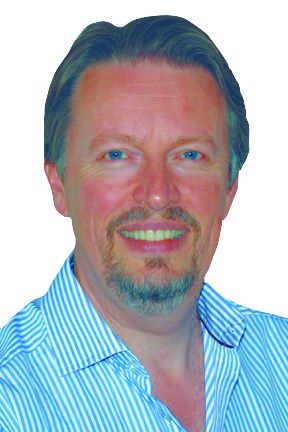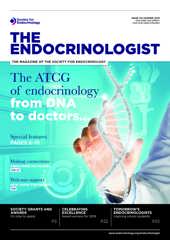I have seen the future. It consists of six billion nucleotides (a tiny bit less if you’re genetically male). Whole genome sequencing (WGS), once a ‘holy grail’, will be routine for many NHS patients in England from 2019.
In a recent clinic, I met an old friend called Robert. I’ve seen him on and off for a decade since he was transferred to me by a colleague who had made a clinical diagnosis of Shprintzen–Goldberg syndrome (SGS) in the days before genetic testing was possible. SGS is a rare genetic condition that shares some features with Marfan syndrome but, in particular, includes a relatively small head and mild learning problems. Mutations in the SKI gene were first described in people with SGS in 2012, although Robert’s SKI genes were tested and found to be normal. Robert lived without a diagnosis until 2pm on 13 March 2019, when I was able to end 31 years of diagnostic uncertainty.
'...when the project officially ended, over 100,000 whole genomes had been sequenced in 85,000 NHS patients...the largest number of genome sequences ever undertaken in a healthcare setting anywhere in the world'
How? He and his parents had taken part in the 100,000 Genomes Project. We were able to analyse far more genes than previously possible and there was the answer: Robert is a compound heterozygote for two different mutations in a gene called ASPM. He has autosomal recessive primary microcephaly type 5. End of story. Or is it?
POLITICS AND AMBITION
The 100,000 Genomes Project in England was the brainchild of politicians determined to make the NHS in England the first healthcare service in the world to use WGS as a routine first-line diagnostic test for people with undiagnosed rare diseases and individuals with cancer. The scale of the ambition was staggering: over a period of 4 years or so, 70,000 NHS patients would undergo WGS (people with cancer undergo WGS in their tumour DNA and their germ line, bringing the total number of genomes to 100,000).
By 29 March 2019, when the project officially ended, over 100,000 whole genomes had been sequenced in 85,000 NHS patients. At the time of writing, this was the largest number of genome sequences ever undertaken in a healthcare setting anywhere in the world.
PRACTICALITIES
People with rare inherited diseases were eligible for WGS if they had specific disorders (see Table 1 for the eligible endocrine disorders) and had already undergone ‘standard’ genetic testing, if available. Priority was given to multi-case families or ‘trios’ (affected child plus both unaffected parents). Consenting to WGS was not trivial: each participant was asked to sign a five-page form with several options relating to the extent of analysis and use of the sample for research (Table 2).
High quality germline DNA, extracted from blood, was shipped to a national biobank, then on to a purpose-built genome sequencing facility on the Wellcome Genome Campus in Hinxton (Cambridge, UK) for WGS, after which analysis was restricted to a panel of carefully selected genes, driven by the reported phenotype, as well as optional ‘secondary findings’ gene panels. Gene panels were defined by a purpose-designed open-access tool called PanelApp.1
People with most solid or haematological cancers were also eligible for WGS in both their tumour and their germ line. Here, however, the project hit two early problems. The first was formalin: this toxic chemical has been used for decades and, although it preserves tissue for histology, it also renders DNA unsuitable for WGS. Operating theatres across England faced (and many still face) the challenge of removing formalin and sending tumour tissue fresh to pathology departments for selection of tissue suitable for DNA extraction. Sounds easy, doesn’t it? It isn’t, believe me.
Haemato-oncologists also faced a challenge: we usually use blood samples to extract germline DNA for WGS, but what if the patient has leukaemia? Alternative sources of germline DNA are needed: skin biopsies, fluorescence-activated cell sorter-enriched non-tumour leucocytes or saliva, for example. This challenge is still being addressed, but it will be solved.
OUTCOMES
At present, the routine 100,000 Genomes Project data pipeline effectively asks ‘is there a variant of interest in these specific genes?’. This is not the same as whole genome analysis, in which the question is ‘is there a variant of interest in this entire genome?’ Cancer data analysis is more complex and requires a broader approach to detect large and small scale genomic rearrangements. Using these current approaches, just over 20% of patients with rare diseases get a diagnosis (on average: the hit-rate is higher for some disorders and lower for others). A greater proportion of cancer patients are found to have a clinically actionable variant that links to a therapy or trial opportunity.
The challenge of data analysis on this scale is truly staggering and, although this ‘first-pass’ analysis might seem relatively restricted, we can expect wider analyses as the data are re-examined periodically as part of the legacy activities of the 100,000 Genomes Project.2
Further analysis of genome data can also be undertaken by researchers working as part of disease-specific GeCIPs (Genomics Clinical Interpretation Partnerships), for example the Endocrine and Metabolism GeCIP.3 These are groups of interested clinicians and academics who have agreed to collaborate on specific projects using the clinical and genome data resource compiled during the 100,000 Genomes Project.
Throughout 2019 we will see the return of thousands of results from Genomics England to the NHS Genomic Medicine Centres. Many centres have already developed a great deal of experience in validating such results and providing clinicians with clinical-grade reports for their clinics.
UNCERTAINTY
'We are Generation Genome.'
One particular challenge is a term you will all need to familiarise yourselves with: ‘variants of uncertain significance’ (VUS or VOUS). At present, our understanding of the genome is relatively basic. We simply haven’t got to grips with the full extent of normal genome sequence variation. It’s a bit like the biggest challenge at medical school: to learn what is normal. It is not uncommon – at present – for DNA sequencing to identify a variant in our DNA that cannot be classified as either ‘normal’ or ‘pathogenic’ (the term ‘mutation’ is falling out of use4). We can expect VUSs to be commonplace for many decades to come, and we will see the rapid development of ‘genomics multidisciplinary teams’ in the NHS to support clinicians faced with a VUS.
One thing has become clear already: accurate, complete phenotyping is vital when it comes to interpreting VUSs. It turns out that diagnostic skills are just as important in the genomic era as ever before.
THE FUTURE
This year, the NHS in England will launch the NHS Genomic Medicine Service. Existing DNA diagnostics provision is being reorganised to create seven Genomic Laboratory Hubs, supported by seven Genomic Medicine Centres, providing comprehensive DNA analysis for both rare diseases and cancer. For the first time, clinicians across the NHS will have direct access to tests – including WGS for some diseases – which may for years have been the sole domain of clinical genetics services. This will not be a single event, but a process that will take time.
We are Generation Genome.5 Genomics is no longer locked in its ivory tower. Let’s work together to realise its full potential for our patients. It’s a big challenge, for sure, but we’re the first health service in the human universe to do it at such scale and pace, so let’s get it right.
Paul Brennan, Consultant in Clinical Genetics, Newcastle Hospitals NHS Foundation Trust, Newcastle upon Tyne
REFERENCES
- Genomics England 2019 PanelApp https://panelapp.genomicsengland.co.uk.
- Genomics England 2019 What Now for 100,000 Genomes Project Participants? www.genomicsengland.co.uk/what-now-for-100000-genomes-project-participants/.
- Genomics England 2016 Endocrine and Metabolism GeCip Domain www.genomicsengland.co.uk/portfolio/endocrine-and-metabolism-gecip-domain.
- Richards S et al. 2015 Genetics in Medicine 17 405–424.
- Davies S 2017 Annual Report of the Chief Medical Officer 2016: Generation Genome www.gov.uk/government/publications/chief-medical-officer-annual-report-2016-generation-genome.






